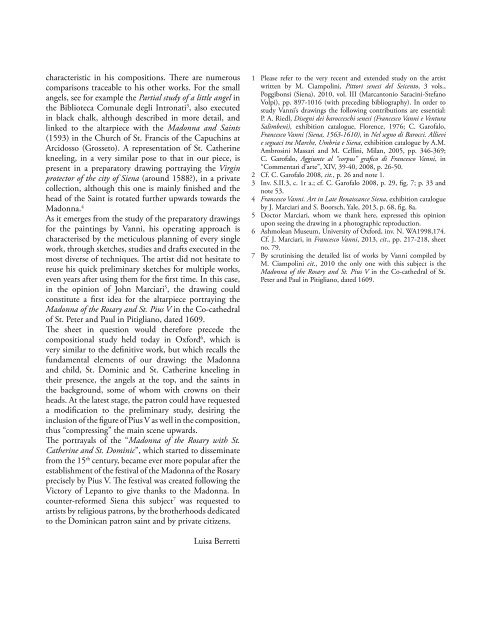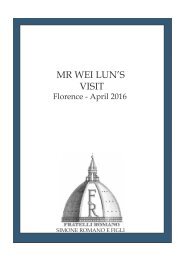A selection of master drawings 2016
- No tags were found...
You also want an ePaper? Increase the reach of your titles
YUMPU automatically turns print PDFs into web optimized ePapers that Google loves.
characteristic in his compositions. There are numerous<br />
comparisons traceable to his other works. For the small<br />
angels, see for example the Partial study <strong>of</strong> a little angel in<br />
the Biblioteca Comunale degli Intronati 3 , also executed<br />
in black chalk, although described in more detail, and<br />
linked to the altarpiece with the Madonna and Saints<br />
(1593) in the Church <strong>of</strong> St. Francis <strong>of</strong> the Capuchins at<br />
Arcidosso (Grosseto). A representation <strong>of</strong> St. Catherine<br />
kneeling, in a very similar pose to that in our piece, is<br />
present in a preparatory drawing portraying the Virgin<br />
protector <strong>of</strong> the city <strong>of</strong> Siena (around 1588?), in a private<br />
collection, although this one is mainly finished and the<br />
head <strong>of</strong> the Saint is rotated further upwards towards the<br />
Madonna. 4<br />
As it emerges from the study <strong>of</strong> the preparatory <strong>drawings</strong><br />
for the paintings by Vanni, his operating approach is<br />
characterised by the meticulous planning <strong>of</strong> every single<br />
work, through sketches, studies and drafts executed in the<br />
most diverse <strong>of</strong> techniques. The artist did not hesitate to<br />
reuse his quick preliminary sketches for multiple works,<br />
even years after using them for the first time. In this case,<br />
in the opinion <strong>of</strong> John Marciari 5 , the drawing could<br />
constitute a first idea for the altarpiece portraying the<br />
Madonna <strong>of</strong> the Rosary and St. Pius V in the Co-cathedral<br />
<strong>of</strong> St. Peter and Paul in Pitigliano, dated 1609.<br />
The sheet in question would therefore precede the<br />
compositional study held today in Oxford 6 , which is<br />
very similar to the definitive work, but which recalls the<br />
fundamental elements <strong>of</strong> our drawing: the Madonna<br />
and child, St. Dominic and St. Catherine kneeling in<br />
their presence, the angels at the top, and the saints in<br />
the background, some <strong>of</strong> whom with crowns on their<br />
heads. At the latest stage, the patron could have requested<br />
a modification to the preliminary study, desiring the<br />
inclusion <strong>of</strong> the figure <strong>of</strong> Pius V as well in the composition,<br />
thus “compressing” the main scene upwards.<br />
The portrayals <strong>of</strong> the “Madonna <strong>of</strong> the Rosary with St.<br />
Catherine and St. Dominic”, which started to disseminate<br />
from the 15 th century, became ever more popular after the<br />
establishment <strong>of</strong> the festival <strong>of</strong> the Madonna <strong>of</strong> the Rosary<br />
precisely by Pius V. The festival was created following the<br />
Victory <strong>of</strong> Lepanto to give thanks to the Madonna. In<br />
counter-reformed Siena this subject 7 was requested to<br />
artists by religious patrons, by the brotherhoods dedicated<br />
to the Dominican patron saint and by private citizens.<br />
1 Please refer to the very recent and extended study on the artist<br />
written by M. Ciampolini, Pittori senesi del Seicento, 3 vols.,<br />
Poggibonsi (Siena), 2010, vol. III (Marcantonio Saracini-Stefano<br />
Volpi), pp. 897-1016 (with preceding bibliography). In order to<br />
study Vanni’s <strong>drawings</strong> the following contributions are essential:<br />
P. A. Riedl, Disegni dei barocceschi senesi (Francesco Vanni e Ventura<br />
Salimbeni), exhibition catalogue, Florence, 1976; C. Gar<strong>of</strong>alo,<br />
Francesco Vanni (Siena, 1563-1610), in Nel segno di Barocci. Allievi<br />
e seguaci tra Marche, Umbria e Siena, exhibition catalogue by A.M.<br />
Ambrosini Massari and M. Cellini, Milan, 2005, pp. 346-369;<br />
C. Gar<strong>of</strong>alo, Aggiunte al “corpus” grafico di Francesco Vanni, in<br />
“Commentari d’arte”, XIV, 39-40, 2008, p. 26-50.<br />
2 Cf. C. Gar<strong>of</strong>alo 2008, cit., p. 26 and note 1.<br />
3 Inv. S.II.3, c. 1r a.; cf. C. Gar<strong>of</strong>alo 2008, p. 29, fig. 7; p. 33 and<br />
note 53.<br />
4 Francesco Vanni. Art in Late Renaissance Siena, exhibition catalogue<br />
by J. Marciari and S. Boorsch, Yale, 2013, p. 68, fig. 8a.<br />
5 Doctor Marciari, whom we thank here, expressed this opinion<br />
upon seeing the drawing in a photographic reproduction.<br />
6 Ashmolean Museum, University <strong>of</strong> Oxford, inv. N. WA1998,174.<br />
Cf. J. Marciari, in Francesco Vanni, 2013, cit., pp. 217-218, sheet<br />
no. 79.<br />
7 By scrutinising the detailed list <strong>of</strong> works by Vanni compiled by<br />
M. Ciampolini cit., 2010 the only one with this subject is the<br />
Madonna <strong>of</strong> the Rosary and St. Pius V in the Co-cathedral <strong>of</strong> St.<br />
Peter and Paul in Pitigliano, dated 1609.<br />
Luisa Berretti





